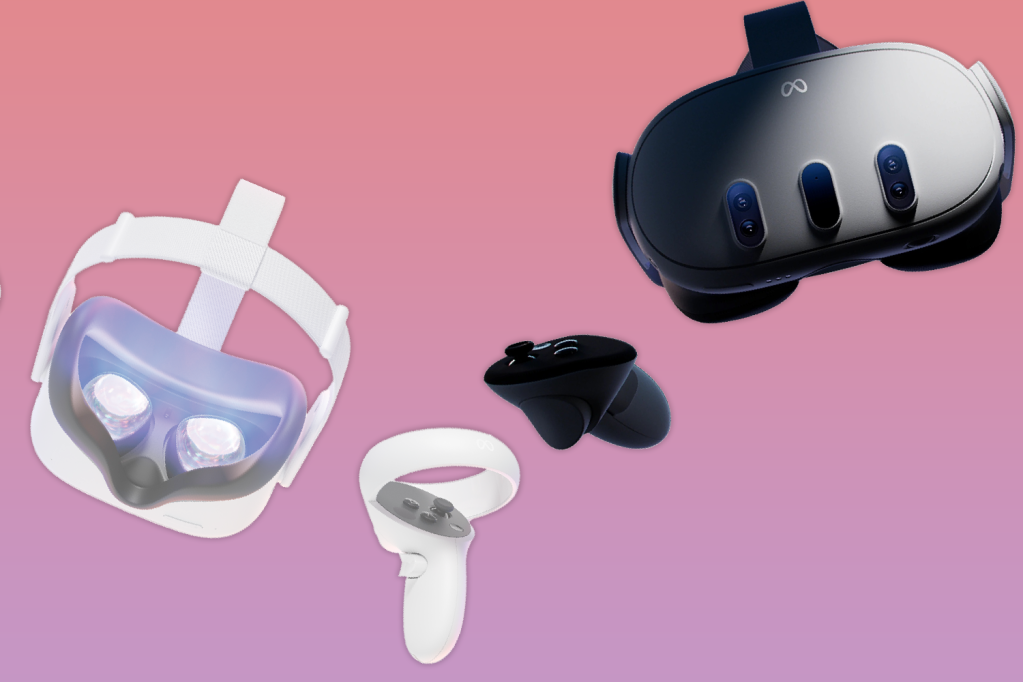Meta Quest 2 vs Quest 3: what’s the difference?
Should you upgrade? Here's how the two VR headsets compare on paper

Three years have passed since we first popped the Meta Quest 2 over our heads and immersed ourselves in Mark Zuckerberg’s somewhat disconcerting virtual world. And it succeeded. The Quest 2 is Meta’s best selling VR headset to date, and can almost be considered a games console in its own right.
It’s unsurprising then, that Meta hopes to keep the momentum going with the Meta Quest 3. Launching on 11 October, the Quest 3 promises upgrades in pretty much every conceivable way. But do they actually make a difference? Our dedicated review will be coming shortly, but until then here’s how the two VR headsets compare on paper.
Design and fit: trimmer winner

First off, the Quest 3 rocks a thinner build than its Quest 2 counterpart. It’s around 40% thinner than the Quest 2, thanks to the use of pancake lenses that need much less room. At 515g, including headset, fabric strap and facial interface, the Meta Quest 3 is a little denser than the Quest 2, which weighs in at 503g. Both get considerably heavier if you add their respective Elite Strap accessories. The pancake optics also make a difference to comfort, moving the centre of gravity closer to your face and putting less pressure on the head strap.
Design-wise, little has changed between the Quest 2 and 3, aside from three panels on the front that hold the outward facing cameras and sensors on the Quest 3. There’s also a dedicated dial for adjusting the optics now. Redesigned headphones mean the new headband arms aren’t interchangeable with the old ones, but they look pretty similar.
Each of the Quest 3’s Touch Plus controllers weighs 126g, including a single AA battery. They ditch the tracking rings seen on Quest 2, without compromising their tracking abilities – thanks in part to IR sensors. AI object detection also does a lot of heavy lifting now. The haptics have been improved, bringing new sensations and tension to your fingertips that let you feel the pull of a bow string in real time. Another major feature is in something called ‘Direct Touch’, which follows hand gestures as you interact with what you’re seeing on the screen.
Speed, storage & screen: gamer friendly

For the Quest 3 to offer Quest 2 gamers an appealing upgrade, it needed some powerful kit under the hood. It gets just that, in the form of Qualcomm’s Snapdragon XR2 Gen 2 chip and 8GB of memory. It promises twice the graphics power of the Meta Quest 2, which uses a 1st-gen Snapdragon XR2 chip and 6GB of RAM. This is the first VR headset to use the new silicon.
The Meta Quest 3 comes with either 128GB or 512GB of storage space, up from 128/256GB on the Quest 2.
Meta has boosted the Quest 3’s per-eye resolution to 2064×2208, up from 1832×1920 on Quest 2. Text will look sharper and images will have more visual fidelity. The Quest 3 also offers a wider field of vision over the Quest 2, by around 15%, for more immersive VR experiences.
Mixed reality: depth perfection?

Meta’s mixed-reality efforts have really stepped up for this latest Quest generation. The Quest 2’s passthrough function was largely a blurred, pixelated mess that had you banging into tables and chairs. It was improved with the Quest Pro, but not substantially enough to make it a viable feature most people would actually use.
The Quest 3’s mixed-reality capabilities have been totally reworked with two RGB passthrough cameras, which have over 10x more pixels on show compared to Quest 2. Depth perception in the Quest 3 has also been given a performance boost, which is a much welcomed improvement.
Price

At $500/£480 for the 128GB or $650/£620 for the 512GB model, the Meta Quest 3 is more expensive than the Quest 2 was on launch. The Meta Quest 2 is currently on sale for $300/£300, so the Quest 2 certainly wins here on price. However, anyone that has yet to make the jump will want to consider holding out until they have a little more cash, as the new features and performance seem worth paying extra for.
Meta Quest 2 vs Quest 3 initial verdict
We’re yet to give the Meta Quest 3 a run for its money with a dedicated review, but for now it seems to beat its older sibling in everything but price. Better graphics, a comfier fit, more pixels and a Snapdragon XR2 Gen 2 chip all seem to offer very real, practical improvements on the Quest 2.